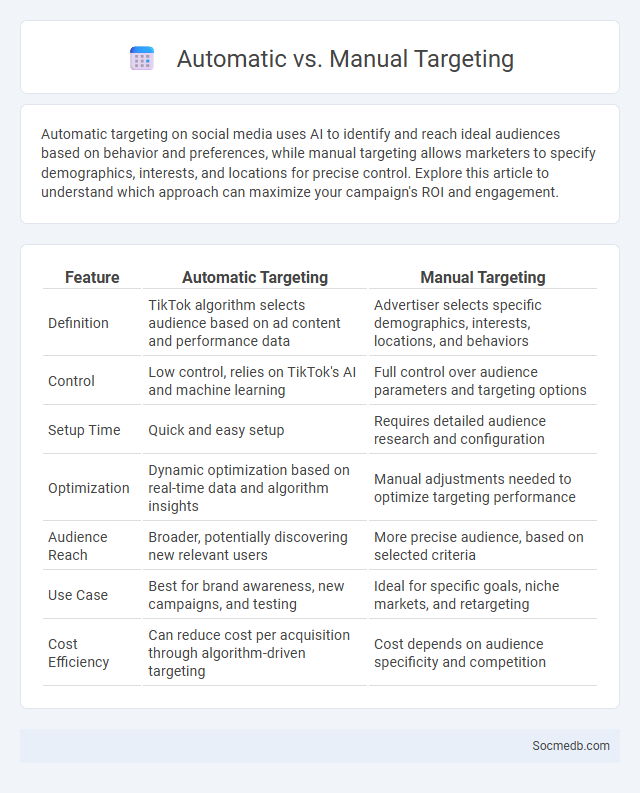
Photo illustration: Automatic vs Manual targeting
Automatic targeting on social media uses AI to identify and reach ideal audiences based on behavior and preferences, while manual targeting allows marketers to specify demographics, interests, and locations for precise control. Explore this article to understand which approach can maximize your campaign's ROI and engagement.
Table of Comparison
| Feature | Automatic Targeting | Manual Targeting |
|---|---|---|
| Definition | TikTok algorithm selects audience based on ad content and performance data | Advertiser selects specific demographics, interests, locations, and behaviors |
| Control | Low control, relies on TikTok's AI and machine learning | Full control over audience parameters and targeting options |
| Setup Time | Quick and easy setup | Requires detailed audience research and configuration |
| Optimization | Dynamic optimization based on real-time data and algorithm insights | Manual adjustments needed to optimize targeting performance |
| Audience Reach | Broader, potentially discovering new relevant users | More precise audience, based on selected criteria |
| Use Case | Best for brand awareness, new campaigns, and testing | Ideal for specific goals, niche markets, and retargeting |
| Cost Efficiency | Can reduce cost per acquisition through algorithm-driven targeting | Cost depends on audience specificity and competition |
Understanding Automatic Targeting
Automatic targeting in social media leverages machine learning algorithms to optimize ad delivery based on user behavior, interests, and demographics. This technology analyzes vast datasets to identify and engage your ideal audience with precision, increasing the efficiency of your marketing campaigns. Understanding how these algorithms function enables you to refine your strategy and achieve better conversion rates.
Exploring Manual Targeting
Manual targeting on social media allows you to precisely define your audience based on demographics, interests, and behaviors, enhancing ad relevance and engagement. By leveraging detailed filters such as age, location, and user activities, your campaigns can focus on users most likely to convert. Effective manual targeting improves ROI by minimizing wasted impressions and directing your budget toward high-potential prospects.
What is Audience Targeting?
Audience targeting is the strategic process of identifying and reaching specific groups of users on social media platforms based on demographics, interests, behaviors, and online activity. This technique enables advertisers and marketers to deliver personalized content and ads, maximizing engagement and conversion rates. Leveraging data analytics and platform algorithms, audience targeting enhances campaign efficiency by focusing resources on the most relevant and receptive individuals.
Key Differences Between Targeting Methods
Social media targeting methods vary primarily in their approach to audience segmentation, including demographic, behavioral, and interest-based targeting. Demographic targeting focuses on age, gender, and location, while behavioral targeting uses user actions and purchasing patterns to refine ads. Interest-based targeting leverages user preferences and engagement data, enabling precise ad delivery to those most likely to convert.
Advantages of Automatic Targeting
Automatic targeting in social media advertising leverages machine learning algorithms to identify and reach the most relevant audience, improving campaign efficiency and reducing manual effort. This technology enhances conversion rates by delivering personalized content based on user behavior, demographics, and interests. Brands benefit from increased ROI as automatic targeting optimizes ad spend by continually refining audience segments in real time.
Benefits of Manual Targeting
Manual targeting on social media enables precise audience segmentation based on specific demographics, interests, and behaviors, increasing ad relevance and engagement rates. It allows advertisers to optimize budget allocation by focusing on high-value prospects, reducing ad spend wastage. Enhanced control over targeting parameters leads to improved campaign performance and higher return on investment (ROI).
When to Use Audience Targeting
Audience targeting on social media is most effective when launching new products or campaigns to ensure content reaches users most likely to engage or convert. It also improves ad spend efficiency by focusing on specific demographics, behaviors, and interests, thereby increasing click-through and conversion rates. Brands should use audience targeting during seasonal promotions or retargeting campaigns to maximize relevance and ROI.
Performance Comparison: Automatic vs Manual vs Audience
Performance comparison of social media strategies reveals that automatic tools offer speed and consistency, while manual management allows for nuanced engagement and tailored content. Audience-driven approaches leverage real-time feedback and preferences, enhancing relevance and interaction. Your choice depends on balancing efficiency, personalization, and audience insights to maximize social media impact.
Cost Efficiency and ROI Analysis
Social media marketing delivers cost efficiency by enabling precise audience targeting and flexible budget allocation, reducing wasted ad spend. Platforms like Facebook and Instagram offer detailed ROI analysis tools that track engagement metrics, conversion rates, and customer acquisition costs. This data-driven approach maximizes return on investment by optimizing campaigns and adjusting strategies in real-time based on performance insights.
Choosing the Right Targeting Strategy
Selecting the right social media targeting strategy involves analyzing your audience demographics, interests, and online behaviors to ensure your content reaches the most relevant users. Utilizing data-driven tools like Facebook Pixel or Instagram Insights allows you to refine your targeting by monitoring engagement and conversion rates. By choosing effective targeting methods, you increase the chances that your message connects with Your ideal customers, maximizing your campaign's return on investment.
 socmedb.com
socmedb.com